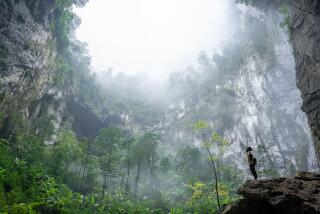Pieces of World War II history are frozen in time
CAEN, FRANCE â The memories are 64 years old but retold with the clarity of yesterday: a young boy lowered by rope into a deep, dark cave, watching the sky above shrink to a small and distant patch of blue.
That hole was home for a month for Gerard Mangnan, his family and dozens of others. And it probably saved their lives. While they huddled underground, Allied and Nazi troops above were waging one of the toughest battles of the D-Day invasion.
Now, generations later, the story of how caves and quarries became bomb shelters during the 1944 battle for the Normandy city of Caen is being brought alive by an amateur archaeologist, his photographer colleague and the memories of survivors like Mangnan.
Most remarkably, the cave enthusiasts -- Laurent Dujardin and Damien Butaeye -- have rediscovered quarries that had been largely undisturbed since the war, mysterious and eerie worlds frozen in time.
A shoe. A rusty bike. A childâs coloring book. Jewelry. Cough mixture bottles. A box of Ridgways Finest Darjeeling Tea (âGrown at the altitude of 3,000 feet,â says the still-visible lettering).
Souvenir hunters with metal detectors have long picked over Normandyâs battlegrounds, but underground, in these virtual time capsules, âyou have the feeling that people were still there 24 hours beforehand and, most important, it has never been manipulated, picked up, moved,â historian Stephane Simonnet, of Caenâs war museum, said in an interview.
Butaeye and Dujardin guided journalists through one cave where several hundred people had taken shelter. In the cold, damp cave, it was easy to imagine the people packed together, children wailing, old men groaning, the stink and discomfort, everyone wondering whether the relentless Allied bombing would bring down the rock overhead and bury them alive.
âThey lived with the cold, with fear. Some were sick. There were a lot of respiratory diseases. So conditions were very difficult. There was the lack of food, the stress. Those who went outside to get food risked getting hurt or killed,â said 55-year-old Dujardin.
Caen, straddling the River Orne, was occupied by German troops and was a key objective for the Alliesâ attack on Adolf Hitlerâs heavily defended Western front.
At dawn on D-Day, June 6, 1944, the bombing and shelling began, and lasted more than two months. Allied planes sometimes dropped leaflets before a raid, warning, âThe vital objective near which you find yourself will be continuously attacked. . . . Leave now! You donât have a minute to lose.â
British troops liberated one bank of the Orne on July 9; Canadians liberated the other on July 19. German forces counterattacked but were finally beaten back, and lobbed their last shells on the city center on Aug. 10, said Simonnet.
In all, he said, 10,000 tons of Allied bombs fell. Three-quarters of the city was destroyed. Distinguished by big red crosses painted on sheets hung on their roofs, churches were largely spared, but otherwise âvirtually nothing was left,â he said. About 2,000 of Caenâs inhabitants were killed.
But for many others, Caenâs quarries proved a lifeline. The city and its surroundings are riddled with caves from which Caenâs famous limestone was extracted for centuries, ferried up the Orne to build such faraway monuments as the Tower of London and Cologne Cathedral.
Roughly one-third of Caenâs 60,000 inhabitants took refuge in about a dozen quarries, the biggest sheltering 8,000 to 10,000 people, Simonnet said. Some stayed a few days, others longer. Some emerged at day and returned at night. Mangnan, then 7, was underground for weeks without coming up.
The cave that journalists toured burrowed dozens of yards into a hill. Its entrance, behind a house, was barely shoulder-wide, a narrow slippery crack in the rock that led down to larger caverns.
There, refugees slept on mattresses, straw or piles of wood shavings. Families marked their space by piling stones into little walls that are still visible.
Here lay a rusty fork and spoon, there, an ink bottle still screwed shut with ink inside.
One quarry-shelter had an abattoir, Dujardin said. Soup kitchens served stew, made with animals killed or injured in the bombings. He said crucifixes were found in the dust, along with a lens from a motorcyclistâs goggles, glass vials of antibiotics and surgical stitching cord, and two syringes -- all presumably from an underground hospital.
âThere was even a post office in one quarry, with the mail going every night,â he said.
Mangnan said 50 people huddled in his cave. A pot served as a common toilet. A woman in labor was hauled to the surface to give birth in a nunnery.
Canadian troops once visited. âThey brought us chewing gum, biscuits in square tins and tobacco in round tins for the men,â said Mangnan, now 71.
He whiled away time playing or doing chores, such as collecting water or peeling vegetables. âWe knew it was daytime because of the blue squareâ of light at the mouth of the cave, he said.
His elder brother Roger, then 18, was killed June 23, 1944, when he fell down the hole. Venturing outside, Roger had stolen some machine gun ammunition from the Germans. They chased him back, shooting. He leaped for the rope, but let go as he slid down.
âShots were crackling around the hole,â said Mangnan. âHe fell at my feet, behind me.â
Finally, in July, they deemed it safe to climb out. Mangnan described the long scramble upward by ladder as âthe fright of my life.â âMy mother said, âdonât look around, climb, climb, climb,â â he recalled.
They emerged to scenes of devastation, of hedgerows torn up and walls caved in.
Mangnan, his old memories tinged with almost boyish wonder, recalled seeing open boxes of artillery shells, jeeps and lorries rushing about, a Canadian field hospital, the burned shell of a German ammunition truck.
And his family home, its roof caved in.
In the postwar rebuilding of buildings and lives, the weeks underground tended to be pushed into Caenâs collective subconscious, Simonnet said. Survivors preferred not to relive their wretched experiences, and historians concentrated on the battles and the soldiers who fought them rather than on the civiliansâ plight.
âPeople spoke about the landings and the liberators, but we havenât spoken until now of this daily life, living a little like hidden rats, in the humidity and dark, with death, pestilence and lice,â he said.
âPeople brought their beds, their bikes, their mattresses, small pieces of wooden furniture. . . . There were births, deaths, underground hospitals, kitchens -- a real subterranean life that had been a bit underestimated until now.â
More to Read
Sign up for The Wild
Weâll help you find the best places to hike, bike and run, as well as the perfect silent spots for meditation and yoga.
You may occasionally receive promotional content from the Los Angeles Times.






